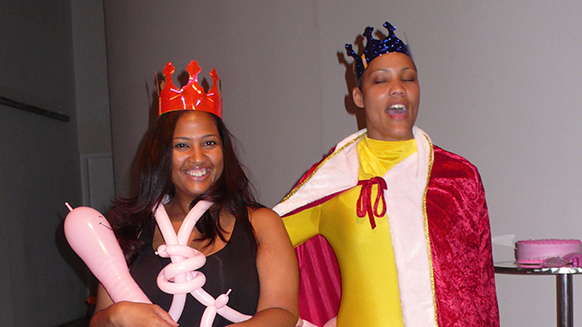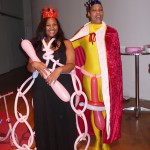FRANCHESKA ALCÁNTARA
The Quince Game
For The Quince Game performance I explore the tradition of the quinceañera, a popular heteronormative coming of age celebration within the Latino/a community that takes place when a young girl turns 15 years of age. The performance revolves around a board game. Using pink colored chess pieces, participants travel as they roll the dice going up a triangular checkered board that follows a planning timeline to throw a quinceañera’s birthday bash. In addition, players receive a number of mini toy soldiers in various colors that become the equivalent of “playing money,” allowing players to pay for services. Throughout the game, participants win prizes like makeovers, photo-shoots, and dresses. Additionally, players win rehearsal time to (re)prepare for rituals such as “the scooter ride” as well as more traditional ones like “the last doll” that are essential to my narrative of this celebration. The ultimate goal is to “crown” the winner as the quinceañera, the princess of a one-day-fairytale.
Another important part The Quince Game is the emceeing, which I take on by personifying El King Ceinch (a play on words using Spanglish, meaning the king with fifteen inches). Inspired by the fairy tale, The Emperor’s New Clothes, this persona raises questions about the history and traditional role-playing of the quinceañera ceremony. On the story, the emperor gets “new clothes” that everyone pretended to admire until a young boy calls out the emperor as being naked. In the performance, El King Ceinch wears a golden suit and cape as well as a balloon resembling a penis. Such gender-bending symbolism aims to challenge the patriarchy system that usually rules conservative Latino/a societies. Additionally, the sexually implicit tone point to the original intention of the ritual which is to present the pubescent body of the young girl as a matured being ready to bear children and enjoy sex.
A clearly gendered celebration, quinceañeras give us the opportunity to analyze the pressures and demands that girls and youth in general face. The use of toy soldiers, chess pieces, and the (role)playing environment of the performance are a metaphor for the experiences that people go through since gender roles are generally assigned under systematic patriarchies. Furthermore, one needs to consider society’s addiction to excess and the celebrity culture; the process of growing up is full of angst, fears and challenges that lavish and superficial celebrations of quinceañeras do not resolve. With this performance, I hope to bring attention to the need of parenting, encouragement and mentorship that would positively impact young minds to discover who they really are.



